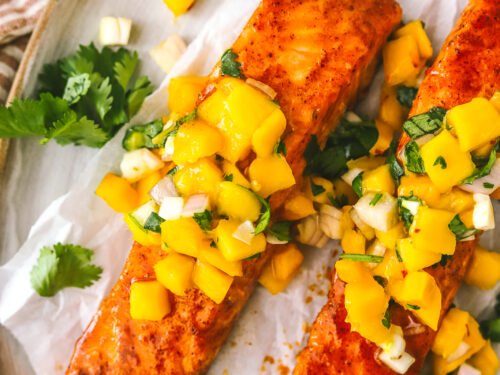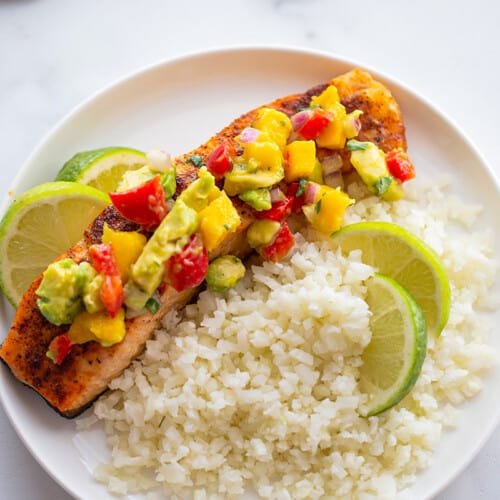Why Mango Salsa Salmon?
Mango Salsa Salmon stands out for several reasons, making it a go-to for home cooks and food enthusiasts:
- Flavor Explosion: The sweet, juicy mango salsa complements the savory, omega-3-rich salmon, creating a harmonious blend of tastes.
- Quick and Easy: Ready in under 30 minutes, it’s ideal for busy schedules.
- Healthy and Nutritious: Packed with protein, healthy fats, vitamins, and antioxidants.
- Versatile Cooking Methods: Grill, bake, or pan-sear the salmon to suit your preference.
- Stunning Presentation: The vibrant colors of the salsa make it a showstopper for any occasion.
This dish is perfect for casual family dinners or elegant gatherings, offering a fresh, modern twist on classic seafood. Let’s explore its origins before diving into the recipe.
The Origins of Mango Salsa Salmon
Salmon is a staple in many cuisines, particularly in the Pacific Northwest and Scandinavian regions, but pairing it with tropical mango salsa is a modern fusion, likely inspired by the rise of global and coastal cuisines in the late 20th century. Mango salsa, with roots in Latin American and Caribbean cooking, gained popularity in the U.S. during the 1980s and 1990s as part of the “Floribbean” culinary trend, blending Florida’s seafood with Caribbean flavors. Combining this bright salsa with salmon—a fish prized for its versatility—created a dish that’s both sophisticated and approachable.
The recipe reflects a broader trend of incorporating fruit-based salsas into savory dishes, adding freshness and acidity to rich proteins. Today, Mango Salsa Salmon is a favorite in coastal restaurants and home kitchens, celebrated for its balance of flavors and ease of preparation.
Ingredients for Mango Salsa Salmon
This recipe serves 4 and uses fresh, accessible ingredients to create a balanced, flavorful dish. The salmon can be grilled, baked, or pan-seared, and the salsa comes together in minutes.
Salmon Ingredients
- Salmon Fillets (4, 5-6 oz each): Skin-on or skinless, preferably wild-caught for optimal flavor and sustainability.
- Olive Oil (2 tbsp): For cooking and seasoning the salmon.
- Lime Juice (1 tbsp): Adds acidity to enhance the fish.
- Paprika (1 tsp): For a smoky, mild flavor.
- Garlic Powder (½ tsp): Adds subtle savoriness.
- Salt (1 tsp): Enhances natural flavors.
- Black Pepper (½ tsp): For a touch of heat.
Mango Salsa Ingredients
- Ripe Mango (1 large, about 1½ cups diced): Sweet and juicy, the star of the salsa.
- Red Bell Pepper (½ cup, diced): Adds crunch and color.
- Red Onion (¼ cup, finely diced): Provides sharp, savory balance.
- Jalapeño (1, seeded and minced): For a mild kick, adjust to taste.
- Cilantro (¼ cup, chopped): Adds fresh, herbaceous notes.
- Lime Juice (2 tbsp): Brightens the salsa.
- Olive Oil (1 tbsp): Rounds out flavors.
- Salt (¼ tsp): To taste.
- Optional: Avocado (1, diced) for creamy richness.
Optional Sides
- Rice: Jasmine or brown rice to soak up the salsa’s juices.
- Grilled Vegetables: Zucchini, asparagus, or corn.
- Salad: Arugula with a citrus vinaigrette.
These ingredients are flexible, allowing substitutions based on availability or preference. For example, use pineapple instead of mango or swap cilantro for parsley if desired.
Equipment Needed
- Grill (gas or charcoal), oven, or large skillet (depending on cooking method).
- Mixing bowl for salsa.
- Tongs or spatula for handling salmon.
- Sharp knife and cutting board for prep.
- Measuring spoons and cups.
- Baking sheet (for oven method) or grill basket (optional).
Step-by-Step Recipe: Mango Salsa Salmon
This recipe focuses on pan-searing the salmon for simplicity, with instructions for grilling or baking included. The salsa is prepared while the salmon cooks, making this a quick 25-minute meal.
1. Prepare the Mango Salsa (10 minutes)
- Peel and dice the mango into ¼-inch cubes. Place in a medium bowl.
- Add diced red bell pepper, red onion, jalapeño, and chopped cilantro.
- Drizzle with 2 tbsp lime juice and 1 tbsp olive oil. Season with ¼ tsp salt.
- Toss gently to combine. If using avocado, fold in gently to avoid mashing.
- Taste and adjust seasoning (more lime juice or salt as needed). Set aside or refrigerate if making ahead.
Prep Tip: Make salsa up to 4 hours in advance and store covered in the fridge for fresher flavors.
2. Season the Salmon (3 minutes)
- Pat salmon fillets dry with paper towels to ensure a good sear.
- Brush both sides with 1 tbsp olive oil and 1 tbsp lime juice.
- Sprinkle evenly with 1 tsp paprika, ½ tsp garlic powder, 1 tsp salt, and ½ tsp black pepper.
3. Cook the Salmon (10-12 minutes)
Pan-Seared (Recommended for Beginners):
- Heat 1 tbsp olive oil in a large skillet over medium-high heat until shimmering.
- Place salmon fillets skin-side down (if skin-on). Cook for 4-5 minutes until the skin is crispy and golden.
- Flip carefully with a spatula and cook 3-4 minutes more until the internal temperature reaches 145°F or the flesh flakes easily with a fork.
- Remove from skillet and let rest for 2 minutes.

Grilled:
- Preheat grill to medium-high (400-450°F). Oil the grates to prevent sticking.
- Place salmon skin-side down on the grill. Close the lid and cook for 4-5 minutes.
- Flip and cook 3-4 minutes more until done. Use a grill basket for easier handling if skinless.
Baked:
- Preheat oven to 400°F. Place salmon on a parchment-lined baking sheet.
- Bake for 10-12 minutes until cooked through, checking for doneness.
Tip: Avoid overcooking; salmon should be slightly pink in the center for optimal texture.
4. Assemble and Serve (2 minutes)
- Place each salmon fillet on a plate.
- Spoon a generous portion of mango salsa (about ½ cup) over each fillet.
- Garnish with extra cilantro or a lime wedge, if desired.
- Serve immediately with suggested sides like rice or grilled vegetables.
Total Time: 25-27 minutes
This recipe yields a vibrant, flavorful dish that’s as nutritious as it is delicious.
Tips for Success
To ensure your Mango Salsa Salmon shines, keep these tips in mind:
- Choose Ripe Mangoes: Look for mangoes that yield slightly to pressure and smell sweet at the stem. Underripe mangoes are tart and fibrous.
- Don’t Overcook Salmon: Use a thermometer (145°F internal) or check for flakiness to avoid dry fish.
- Balance Salsa Flavors: Taste the salsa and adjust lime, salt, or jalapeño for the perfect sweet-spicy-tangy balance.
- Prevent Sticking: For grilling or pan-searing, ensure the cooking surface is well-oiled and hot before adding salmon.
- Prep Ahead: Make the salsa and season the salmon in the morning for an even faster dinner.
- Use Fresh Ingredients: Fresh lime juice and herbs elevate the salsa’s brightness.
Variations to Elevate Your Mango Salsa Salmon
This dish is highly adaptable. Here are creative ways to customize it:
Salsa Variations
- Pineapple Salsa: Swap mango for diced pineapple for a tangier, tropical twist.
- Spicy Mango Salsa: Add an extra jalapeño or a pinch of cayenne for more heat.
- Citrus Mango Salsa: Include diced orange or grapefruit segments for a citrusy burst.
- Herb Swap: Use parsley, mint, or basil instead of cilantro for different flavor profiles.
Salmon Preparations
- Blackened Salmon: Coat with a Cajun spice blend (paprika, cayenne, thyme, oregano) before searing for a bold, spicy crust.
- Honey-Glazed Salmon: Brush with a mix of 1 tbsp honey and 1 tbsp lime juice before cooking for a sweet glaze.
- Teriyaki Salmon: Marinate in a mix of soy sauce, ginger, and honey for 15 minutes before cooking.
Dietary Adaptations
- Vegan: Replace salmon with grilled tofu or cauliflower steaks, seasoned similarly.
- Low-Carb: Serve with cauliflower rice or a green salad instead of regular rice.
- Gluten-Free: The recipe is naturally gluten-free; double-check any spice blends for additives.
Alternative Proteins
- Chicken: Use boneless chicken breasts or thighs, grilled or pan-seared, for a non-seafood option.
- Shrimp: Grill or sauté large shrimp for 2-3 minutes per side and top with salsa.
- White Fish: Try cod or halibut for a milder fish flavor.
These variations make the dish versatile for any palate or dietary need.
Pairing Suggestions
To complete the meal, consider these complementary sides and drinks:
- Sides:
- Jasmine Rice: Absorbs the salsa’s juices for a cohesive plate.
- Grilled Corn: Brushed with lime butter for a summery touch.
- Arugula Salad: Tossed with citrus vinaigrette and shaved Parmesan.
- Roasted Sweet Potatoes: Cubed and seasoned with cumin for heartiness.
- Beverages:
- White Wine: Sauvignon Blanc or Chardonnay to match the tropical notes.
- Beer: A light, crisp lager or wheat beer.
- Non-Alcoholic: Mango-infused sparkling water or a virgin mojito.
- Cocktail: A pineapple margarita or piña colada for a tropical vibe.
- Desserts:
- Coconut sorbet for a refreshing finish.
- Key lime pie to continue the citrus theme.
- Grilled pineapple with a drizzle of honey.
These pairings enhance the tropical, summery feel of Mango Salsa Salmon, making it suitable for casual or festive occasions.
Nutritional Information
Approximate nutritional breakdown per serving (1 fillet with ½ cup salsa, no sides):
- Calories: 350 kcal
- Protein: 30g
- Fat: 20g (4g saturated)
- Carbohydrates: 15g
- Sugar: 10g
- Fiber: 2g
- Sodium: 600mg
This dish is rich in omega-3 fatty acids, vitamin C, and antioxidants, making it a heart-healthy choice. To reduce calories, use less oil or skip the avocado in the salsa.
Storing and Reheating
Mango Salsa Salmon is best enjoyed fresh, but leftovers can be stored:
- Storage: Store salmon and salsa separately in airtight containers in the fridge for up to 2 days. The salsa may soften slightly but remains flavorful.
- Reheating: Gently reheat salmon in a 300°F oven for 8-10 minutes or in a skillet over low heat to avoid drying. Serve salsa cold or at room temperature.
- Freezing: Freeze cooked salmon (without salsa) for up to 1 month. Thaw in the fridge overnight and reheat gently. Salsa does not freeze well due to texture changes.
Why This Recipe Works
Mango Salsa Salmon succeeds because it balances bold flavors with simplicity. The salmon’s rich, fatty texture pairs perfectly with the salsa’s bright, acidic, and sweet components, creating a dish that feels both indulgent and light. The quick cooking methods—whether pan-searing, grilling, or baking—preserve the fish’s moisture and make it weeknight-friendly. The salsa’s versatility allows for endless customization, while the dish’s vibrant presentation elevates it for special occasions. Plus, its nutrient-dense ingredients make it a guilt-free indulgence.

A Dish for Every Occasion
Mango Salsa Salmon is more than a meal; it’s a celebration of fresh, vibrant flavors that bring a taste of the tropics to your table. Whether you’re cooking for a family dinner, impressing guests at a summer barbecue, or meal-prepping for a healthy week, this recipe delivers. Its ease of preparation, stunning appearance, and crowd-pleasing taste make it a staple for any home cook.

